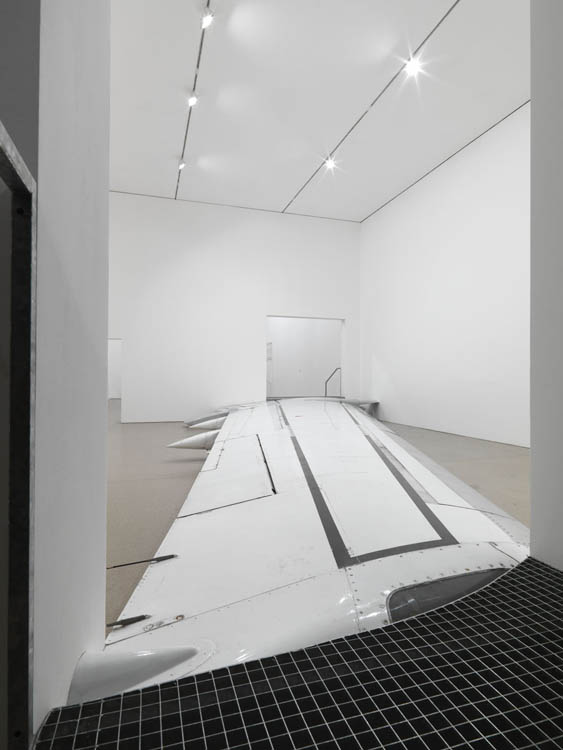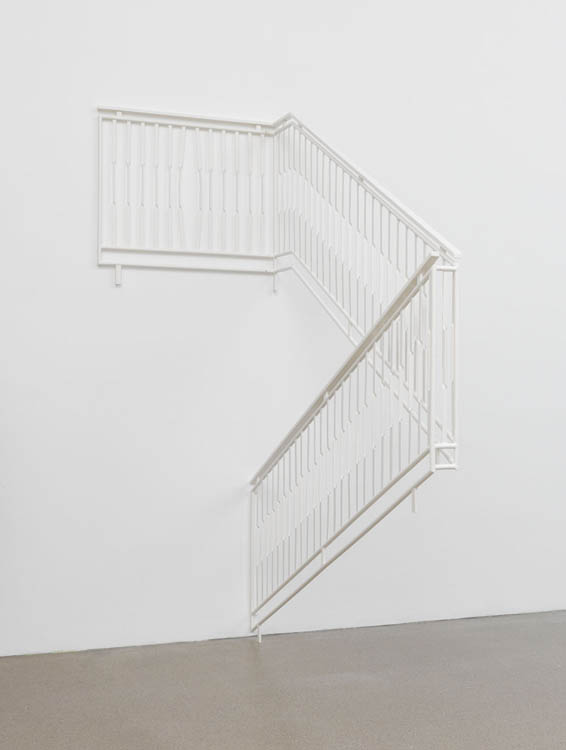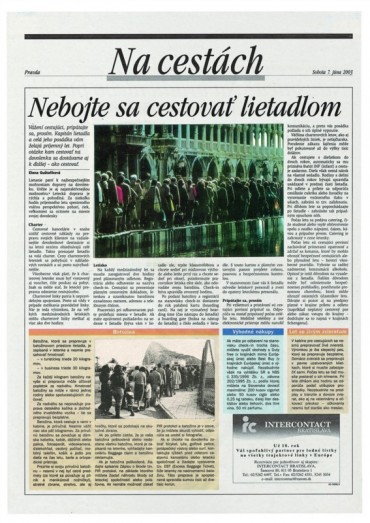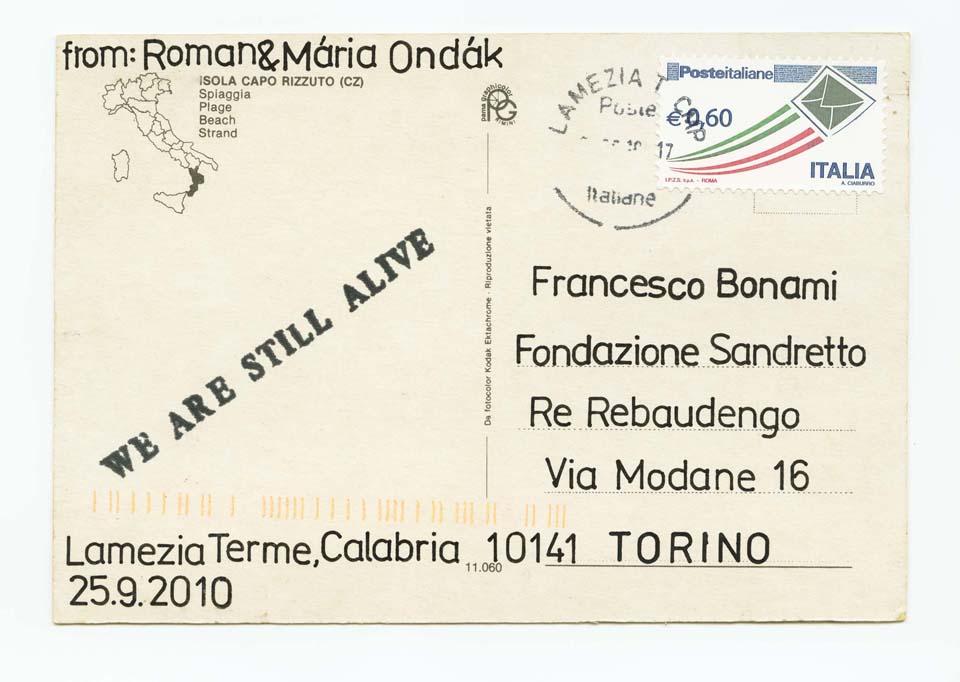
Roman Ondák. "do not walk outside this area," 2012. Installation view, Deutsche Guggenheim, Berlin. Photo: Jens Ziehe. Courtesy the artist.
This week, I took my visiting mother and sister to the Roman Ondák exhibition at that most intimate of the Guggenheims, the Deutsche one. The smallish space continually confounds artists; some try to succumb to it, others to pillage it. I remember being excited by Collier Schorr’s casual and tacit acceptance of the space with her curated show “Freeway Balconies,” and then later being totally weirded out by Anish Kapoor’s enormous copper-colored uvula, which seemed like an exhausting and sad attempt at sculptural virility.
Ondák’s exhibition on the other hand is sparse and delicate, peppered with newspaper clippings and door handles, accompanied by only one bombastic gesture involving the severed wing of an airplane. To gain access to the second half of Ondák’s show, viewers are compelled to walk across the wing; on which is printed the familiar and, one would hope, redundant plea “do not walk outside this area.”
do not walk outside this area is also the title of Ondak’s show, and may refer to the arbitrary and absurd parameters we make for ourselves or are imposed on us in both art and life. With his piece, Ondák invites us to transgress the most sacred of bodily commandments, and glide across the smooth metal unaided by a rope, a buddy or a hallucinatory William Shatner. I have to say that despite the wing’s low position I experienced a child-like thrill on my 10-second passage. If you can ignore the museum guards on both sides, you might feel something irreverent and liberating, something my sister would later cite as the show’s high point, stating succinctly that “the airplane wing was cool.”
In the front room Ondák presents a slightly reconfigured awning from his parents’ house. It protrudes from the wall in manufactured eggshell white, straddling the line between formalist intervention and sweet personal sendup. Ondák works best in the vein of personal-as-public. One of his earlier and better-known pieces is a post-it note that says “Deadline postponed until tomorrow,” a personally derived message that is universally well-received.

Roman Ondák, "Leap," 2012. Installation view, Deutsche Guggenheim, Berlin. Photo: Jens Ziehe. Courtesy the artist.
Ondák, a Slovakian conceptual artist working in Bratislava, has gained clout in the last few years with sly installations that blur and make malleable the dueling statuses of insider/outsider. For his contribution to the 2009 Venice Biennale, he imbued the Slovak Pavillion with its surroundings in the Giardini, transporting its native greenery and plants back to the hallowed/hollowed interior, creating a real tension between the modest and monolithic gesture.
This year, Ondák gets his due as the Deutsche Bank’s “Artist of the Year.” His quiet and breathy show is a nice departure for this artists’ series, which is usually very drawing-ish (Julie Mehretu, Wangechi Mutu). In fact, one of the criteria states that the artist elected should use paper as a medium, which seems a stretch for the object scavenging Ondák, but is nevertheless mentioned several times in press materials when describing his practice.

Roman Ondák. "Awaiting Enacted," 2003. Courtesy the artist and https://www.monopol-magazin.de/.
But okay, fair enough, do not walk outside this area is full of paper. In the front room Ondák presents a series of collages in which existing newspaper articles are paired with random shots of people waiting in line, a reference to the common phenomenon of queuing in the former east.
In the back room Ondák displays Balancing at the Toe of the Boot, in which he was commissioned to make work about Calabria, a region he was not initially familiar with. During his research he discovered that Calabria was a historically dangerous area, and so, in an homage to On Kawara, he sent regular postcards to curator Francesco Bonami asserting “we are still alive.”

Roman Ondák. "Balancing at the Toe of the Boot (Detail)," 2010. Courtesy of the artist and https://www.monopol-magazin.de/ .
After the trip, Ondák created a series of fictional newspaper stories using his personal vacation snapshots as the photographic lead-ins. This is Ondák’s only tongue-in-cheek moment, toying with the mythic and subjective assessment of oneself.
I should say that a lot of background information was garnered through well-informed museum docents who were keen to offer explanations…in fact, they kind of insisted. One helpful employee told me that the Guggenheim was employing more docents than usual because of the difficulty in deciphering Ondák’s work. I felt and still feel conflicted about this choice, which may prevent multiple meanings but offers greater insight into work that is, because of language barriers, impenetrable to some.
After hearing a few explanations, my mother offered this tiny conceptual art gem: “At first I thought it was just about the worst thing I’d ever seen, but after she explained it to us, I thought he was a pretty decent artist.”



